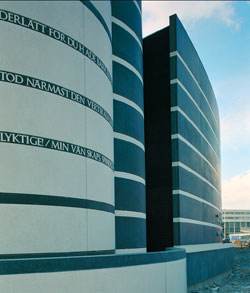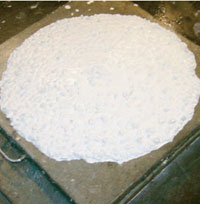Flow with Show: Self-Consolidating Concrete Offers New Opportunities for Architectural Concrete
Architectural concrete is a hot topic. Defined by the American Concrete Institute as “concrete which will be permanently exposed to view and which therefore requires special care in selection of the concrete materials, forming, placing and finishing to obtain the desired architectural appearance,” it is showing its face everywhere. Examples of applications are buildings and transportation structures like bridges and highway sound/barrier walls. Delivery methods include cast-in-place, precast, and tilt-up, and in every case, good appearance is essential. Achieving good surface characteristics requires thorough consolidation of the fresh concrete and thoroughly filled forms. Fortunately, this also leads to a durable material because water, precipitation, and aggressive chemicals or ions are shed by the surface skin.
Conventional concrete is placed using vibrators to fill the forms. Self-consolidating concrete (SCC) is a big step forward in fool proofing that procedure.
Self-Consolidating Concrete
The construction industry has always longed for a high-performance concrete that can flow easily into tight and constricted spaces without requiring vibration. The need for this technology has grown as designers specify more heavily reinforced concrete members and ever more complex formwork. Honeycombing or exposed reinforcement in structural walls or columns is a constant concern in these structures.

Slim and accurate architectural constructions are much easier to realize with SCC, such as this 83-meter high Stockholm Airport tower, which is decorated with excerpts from the work of Antoine de Saint-Exupéry. Reduced noise levels made construction during nighttime hours possible. Photo courtesy: Heidelberg Cement.
Conventional concrete is placed using vibrators to fill the forms. Self-consolidating concrete (SCC) is a big step forward in fool proofing that procedure.
Until recently, the industry used superplasticizing admixtures (also known as high-range water reducers) in conventional mixtures in an attempt to achieve flowable concrete and duplicate the advantages of a true self-consolidating concrete. This allowed the use of concrete having an 8-inch or greater slump; however, some vibration was still required for adequate consolidation. While high doses of superplasticizers can create a very fluid concrete that flows readily, the concrete will segregate if the mortar is too thin to support the weight of the coarse aggregate. The key to creating SCC, also referred to as self-compacting, self-leveling, or self-placing concrete, is to produce a very flowable mortar that retains a viscosity great enough to support the coarse aggregate.
SCC Formulated with White Cement
Architectural expression in concrete means different things to different people. Some designers appreciate concrete for its unadorned appearance. So gray portland cement concrete can receive architectural treatment. Some designers want to use color to express aesthetics, and white portland cement is available to create white or colored concrete. Much of the experimental work to date on SCC has focused on gray cement, but there are opportunities for white cement formulations.

Slump flow test of white SCC. Photo courtesy of Aalborg White.
Concrete producers know that there is quite a bit of development associated with any mix design. When SCC is brought into the equation, the fresh properties are the most important characteristic of the mixture. The concrete has to flow easily (slump flow) including passing through obstructions like rebar (measured by the J-ring test), but has to do so without bleeding or segregating.
If a mixture is designed with gray portland cement, it can be modified to use white portland cement, but the mixture will most likely change somewhat. Testing done by Aalborg Portland A/S identified several suggestions for converting a gray SCC formulation to white cement SCC. (1, 2) They take into account the difference in chemistry of white cement and gray cement, dosages of cement, water and admixtures, etc. Alternately, a mixture can be initially designed in white portland cement.
Testing SCC: New ASTM Standards Are Approved
Flowability, passing ability, and stability are three of the most important characteristics of SCC. In 2001, ASTM started development of test methods that would assess these characteristics. In 2005, the first SCC standard was published: ASTM C1611, Test Method for Slump Flow of Self-Consolidating Concrete, which assesses the flowability of SCC. This was followed in March of 2006 by ASTM C1621, Test Method for Passing Ability of Self-Consolidating Concrete by J-Ring. Test methods to assess static and dynamic stability are currently under development. These standards will be used in the mix design process of SCC as well as a quality control tool.
References
Thrysøe, Jacob, and Hansen, Tommy Bæk, “Self compacting concrete based on white portland cement,”
Concrete Plant International, #1, Concrete Plant International Worldwide, February 2006, pages 84 to 93.
Self Compacting Concrete Based on AALBORG WHITE® Self-Consolidating Concrete Takes Concrete Sustainability to a New Level
Concrete is inherently a sustainable material. Some of its many sustainable properties and applications are further enhanced with the use of self-consolidating concrete (SCC). SCC provides benefits beyond those of conventional concrete in all three aspects of sustainable development: economic, social, and environmental. The most important benefit of SCC is the increase in durability. The uniformity of an SCC mixture reduces the permeability and enhances the overall durability of the concrete. This, in turn, enhances the lifespan of the SCC beyond that of conventional concrete (Corinaldesi 2005); thereby reducing the environmental footprint on a unit time basis.
The use of SCC has been adopted by a large number of precast operations. The self-consolidating property eliminates the need for vibration, which reduces the labor requirement for SCC placement. In some cases, the labor requirement can be half that for conventional concrete (Baumgartner 2003). The energy consumption associated with vibration is also removed. Additionally, the formwork no longer is subject to the stresses of vibration, which can reduce formwork initial cost, maintenance costs, or both. These benefits apply to precast operations as well as cast-in-place operations.
Another benefit associated with the elimination of vibration is the noise reduction. This improves the working environment and safety. This can increase employee productivity by reducing noise-induced and vibration-induced illnesses (Daczko 2006). Additionally, operations located within or near residential or commercial centers may experience less noise-based negative feedback from the neighbors.
The aesthetic quality of SCC formed surfaces allows the bare concrete to be the finish surface. Additional material, such as paint, is not needed. This in turn reduces maintenance requirements and improves air quality.
Environmental concerns can be addressed using benefits already highlighted for the economic and social aspects of sustainable development. The reduction in energy consumption can be directly translated to reduced fossil fuel usage. On top of the reduction in energy due to elimination of vibration, the rapid discharge rate of SCC allows for shorter dwell times of trucks at the job site. Again, this directly translates to a reduction of fossil fuel usage.
Glavind (2005) states that the industry “has suffered from an image of being dirty, noisy, and environmentally unfriendly.” SCC in combination with the sustainable principles of concrete in general can be used to refute this image and show that concrete is the choice for sustainable development.
References
Baumgartner, J., “Application of the Zero Energy System: Self-Compacting Concrete in the Swiss Precast Concrete Industry,”
Betonwerk- und Fertigteil-Technik (Concrete Plant and Precast Technology), Vol. 69, No. 9, 2003, pages 58-66.
Corinaldesi, V. and G. Moriconi, “Rheological Study of Blended Cement Concrete,”
Cement Combinations for Durable Concrete, Thomas Telford, London, 2005, pages 211-218.
Daczko, J. A., and M. Vachon, "Self-Consolidating Concrete (SCC),"
Significance of Tests and Properties of Concrete and Concrete-Making Materials, STP169D, ASTM International, West Conshohocken, Pennsylvania, 2006, pages 637-645.
Glavind, M., D. Mathiesen, and C.V. Nielsen, “Sustainable Concrete Structures: A Win-Win Situation for Industry and Society,”
Achieving Sustainability in Construction, Thomas Telford, London, 2005, pages 1-14.